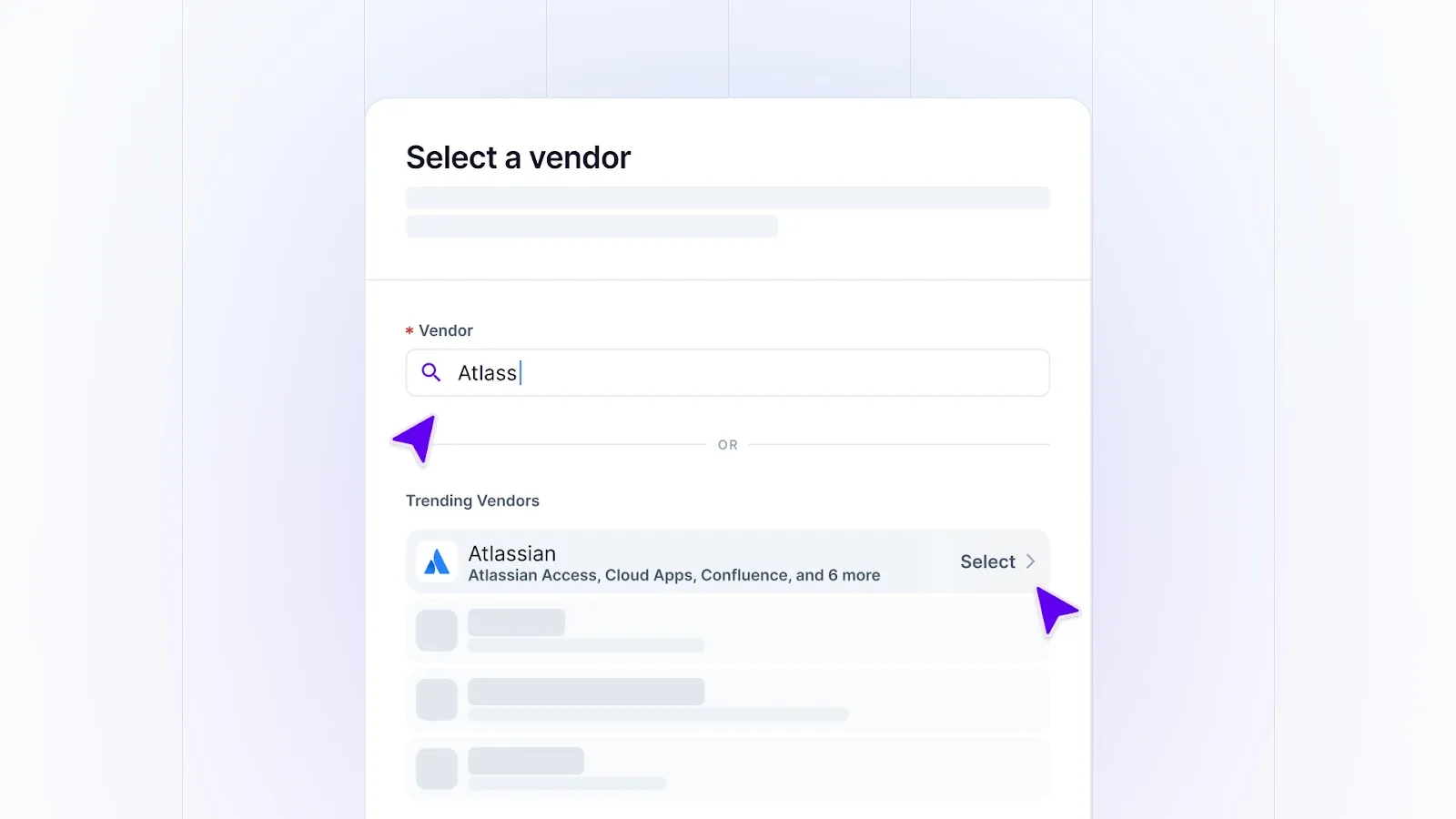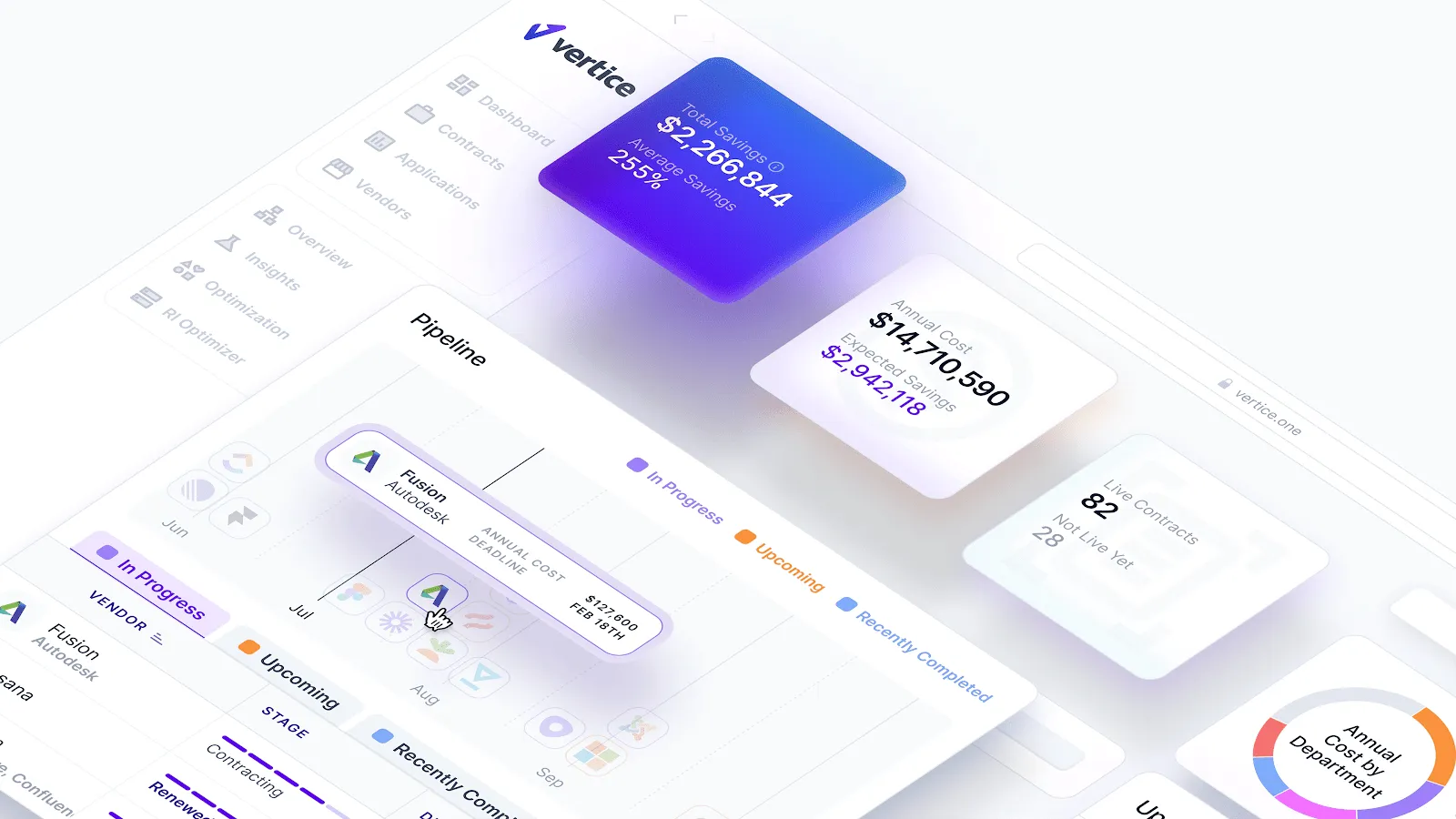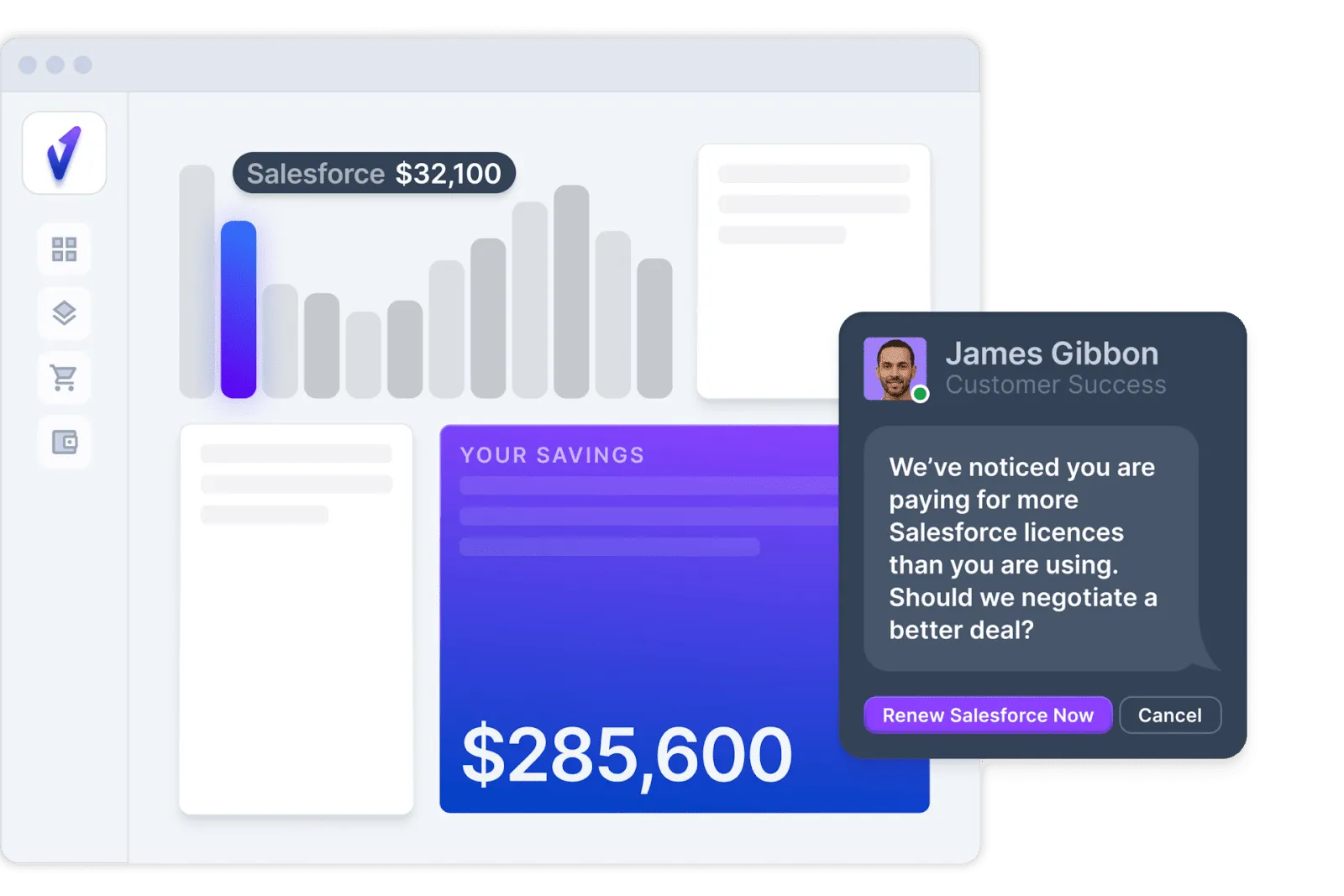What is SaaS Procurement?
Software-as-a-Service (SaaS) procurement (also referred to as SaaS purchasing) is a strand of traditional IT procurement — the process of acquiring the technologies and services businesses need to carry out their daily operations. The difference between the two is that SaaS procurement refers only to the acquisition of company software.
The presence of software in modern businesses has grown at a rapid rate over the last two decades. We estimate that the average company now uses nearly 130 different software tools.
The exact process of SaaS purchasing will vary between organizations, depending on the hierarchy of decision-making, though it typically follows this general outline:
- Identifying business requirements
- Researching prospective tools
- Negotiating with leverage
- Onboarding the new software
Why SaaS procurement is important in business
Software procurement not only provides the business with the tools it needs to function, but those responsible also play an important strategic role in enabling business growth.
They take ownership of a significant spend item on any company’s balance sheet – SaaS is the second largest cost category for a business behind headcount. How they monitor and control this can be linked to business performance metrics.
Plus, the purpose of SaaS is to enable teams and businesses to improve their output and growth potential. If the tools and platforms cannot keep up with this in terms of service and feature provision, then they actually play a role in bottlenecking productivity and restricting business growth.
Therefore, those in SaaS procurement must constantly ensure that the business is supplied with cost-effective tools that can scale with the business without spiraling costs or strangling productivity, or be negotiating with other vendors to get best-fit tooling if the existing platforms cannot meet the necessary requirements.
Procurement SaaS also encapsulates the management of vendor relationships. Maintaining these at a good and productive level helps negotiations proceed more smoothly, can help achieve more favorable contract terms, and also help improve customer service levels throughout the lifespan of any contract.
Finally, having this all centered in a dedicated SaaS procurement process, rather than in the hands of department leaders or general employees, enables a total focus on its requirements rather than being an ‘after-thought’ or a ‘side-activity’ of someone whose attention is likely needed elsewhere.
The current state of SaaS procurement
Effective SaaS procurement is critical for businesses seeking to enhance efficiency, productivity, and competitiveness, but achieving this is hard. Many businesses have taken a scattergun approach to procurement SaaS as a result.
Without a cohesive, clear and centralized strategy, SaaS purchasing can be the cause of spiraling costs, time and inefficient resource allocation, all of which negatively impact a company’s bottom line.
Whilst those that invest in automation and involve procurement in wider strategic planning for the business see benefits in innovation, business growth and speed to market, those that don’t can actually experience significant declines in these areas.
It’s not as simple as including automation however. Software procurement has a multitude of challenges that need to be addressed constantly and effectively as a matter of course.

Challenges in SaaS procurement
SaaS procurement is a multi-faceted, multi-department process. As such, businesses must overcome numerous challenges to ensure successful software procurement initiatives. We’ve highlighted some of these in the list below:
- Identifying the right software — Many tools compete for market dominance across multiple areas. Each of these tools differ slightly in terms of platform features, business suitability and pricing structures, so identifying the right one for your business needs requires meticulous attention to detail.
- Vendor credibility — Research into new SaaS tools should cover both the software and the supplier. You’ll need to have assurances over your vendor’s financial health and whether or not it’s been involved in any recent scandals.
- Negotiation tactics — Both you and your vendor will look to secure a contract that suits them. Within that dynamic, it’s important not to bend to their will and compromise on important aspects of the contract, or engage in aggressive negotiation tactics. There should be a clear negotiation strategy in place, understanding that the best situation is one that benefits both parties.
- Securing SLAs — Service level agreements (SLAs) constitute a significant contract negotiation aspect, laying out your expectations of the level of service you’ll receive from both the supplier and their product. Typical SLA components include product uptime, KPIs, and account support. When suppliers fail to live up to these commitments, there may be legitimate grounds to cancel contracts early.
- Vendor relationships — The best way to secure value over time is to nurture and maintain a healthy partnership with your provider. Mutually beneficial relationships will enhance the quality of the product and service in the long-run.
- Data security — SaaS tools process and hold large amounts of data - for example financial and personal customer data. Data security concerns need to form a pillar of negotiations, including a discussion about who owns any data within the new solution and how this data is protected.
- Integrations — SaaS integrations with existing systems and other software tools are key selling points, but these sometimes come at an extra cost. Be aware of which integrations come ‘out-the-box’ and which are available only as an additional perk.
- Vendor lock-in — It’s within the interests of software vendors to commit their customers to long-term contracts. You’ll likely even receive a significant discount if signing up to a multi-year subscription - a common tactic suppliers use to incentivize customers into making these commitments. If you’re procuring a new solution, there’s lots of uncertainty around its ease-of-use and its performance. Make sure you’re confident of the platform’s facility if looking at a long-term lock-in to achieve consistent cost savings. There’s nothing worse than paying for a subscription you don’t like or need.
- Efficient onboarding — Your arrangement with a new supplier should cover the onboarding process. This refers to the time it takes for your IT team and end-users to familiarize themselves with the product and how it works. Ensuring your supplier helps with the onboarding process and has a scheduled and robust plan helps ensure product buy-in from your business throughout its lifespan.
- SaaS analysis — Although individual procurement projects concentrate on the acquisition of one product, procurement processes are at their most robust when businesses continuously analyze their stack in search of the next solution. Investing in a SaaS purchasing platform is the best way to carry out this analysis.
- Integrations — You’ll ideally want new solutions to integrate with your existing stack. Every solution will have natural integrations included at no extra cost, but they may not be the ones you want or need. Procurement processes need to ensure that a new tool integrates properly with minimal fuss or additional cost.
Longer term challenges also need to be dealt with in any software license procurement process.
These include:
- The influence of shadow IT — ‘hidden’ software within an IT ecosystem not attributable to any one department or employee, and typically acquired outside of existing procurement policies.
- Identifying mis-matched software and tooling which can restrict company growth trajectories.
- Preventing / solving a lack of visibility into your tech stack and contractual information that can lead to duplicated tools and significant security and compliance issues.
What does effective SaaS procurement look like?
To ensure new software acquisitions deliver the intended benefits, SaaS procurement requires a well-defined software licence procurement process that takes several key factors into account, including:
- Requirements assessment – At the outset, thorough consultation takes place with stakeholders to identify the specific needs and objectives of the business. Any new tool or platform, no matter how broad or focused, must meet these requirements.
- Vendor analysis – Procurement teams will want to evaluate the available services, taking a data-driven approach using key metrics mapped to business requirements in order to make informed decisions. SaaS procurement teams might analyze potential ROI, competitiveness and cost savings, lead times, and vendor uptime and availability.
- Security and compliance – Rigorous assessments of the vendor’s security should be made. Both internal and external security risks will be analyzed, as well as how the selected tool fits compliance requirements. This research is usually undertaken by IT and Legal teams, collaborating with SaaS purchasing teams as part of the overall project.
- Budget and pricing – An accurate picture of the total cost of ownership (TCO) is vital. Pricing models, schedules and terms will need to be crystal clear in order to avoid any unpleasant financial surprises once the contract is signed. Any ROI benefits will need to be included here too, as an expensive outlay may unlock higher business growth - it’s not all about the cheapest option.
- Contract negotiations – Working with the vendor and your legal team to devise a robust SaaS contract can ensure there are no unpleasant surprises following procurement. A clear and enforceable service-level agreement (SLA) should outline rights, responsibilities, termination clauses, and data ownership terms. Consider asking for the removal of any auto-renewals clauses so you’re better positioned as you near the end of the service lifecycle. Other contractual issues to consider include data security, indemnification, liability limitations, and dispute resolution mechanisms.
- SaaS system of record – It’s wise to set up (or add your new tool to if you have one already) a SaaS management platform, tracking document or system of record (SSoR). Such a system helps track all your SaaS applications, including their licenses, renewal dates, and overall expenditures, as well as utilization and performance of your solutions. The Vertice platform offers this functionality and can make your business more cost-effective.
A lot of these steps can be conducted manually, or through various tools and systems. However this creates delays, bottlenecks and confusion, leading to information going missing at vital moments, contracts being improperly negotiated, and costs spiraling.
It’s increasingly common for businesses to look for a technological solution to this pain. A SaaS purchasing platform and procurement partner like Vertice helps keep the whole process centralized, totally visible and streamlined - so you have all the information and data you need to conduct an effective negotiation.

What is a SaaS purchasing system?
A SaaS purchasing system is a central platform that your procurement team can use to conduct all of their procurement processes and negotiations, and hold all the necessary contract and tech stack information, data and benchmarks.
It provides much higher levels of control, stack knowledge and visibility, and analytics than other more disparate solutions - like spreadsheets or off-the-shelf project management tools.
The advantages of using a SaaS purchasing system
Here are the key advantages of using SaaS purchasing software to support your procurement processes:
- Centralized management – With all your SaaS vendors managed within a single platform, it’s easy to manage multiple services and subscriptions. For example, Vertice’s unified platform combines this benefit with greater cloud visibility across your environment, enabling you to holistically monitor all aspects of your solutions.
- Efficient spending – With a clear picture of how your organization is using products, you can make sound financial decisions by reducing technology overlap or eliminating unused subscriptions. Furthermore, SaaS purchasing software such as the Vertice platform can help you get the best price for your solutions by negotiating on your behalf whilst also aiding software spend management with expert cost-saving recommendations.
- Shadow IT mitigation – The use of shadow IT by employees is typically the result of shortcomings in your existing stack, either through visibility limitations or a shortfall in capability. With an effective SaaS purchasing system, it’s quicker to approve new software and tools that improve workforce efficiency, in turn reducing the use of unauthorized tech.
- Vendor management – Under a centralized procurement platform, you can streamline processes surrounding vendor selection, evaluation, and contract management. Consistent performance monitoring through in-depth reporting means you can be sure you’re getting what you’re paying for, making vendor relationship management considerably easier.
- Compliance and security – With greater understanding of your stack, your IT teams can more quickly be alerted to potential risks or attack vectors and better leverage the security measures of your SaaS providers. Closer monitoring of your vendors can help ensure compliance and regulatory requirements are met, or seamlessly remediate the situation where things fall short.
- Renewals management – With the average company using more than 100 SaaS applications, staying on top of renewals can be burdensome. Underutilized tools and auto-renewal clauses can lead to wasted spend. With proper oversight of your SaaS licenses and renewal dates, you’ll ensure there’s no disruption to the services you do need and find opportunities to save on the services you don’t.
- Agility and scalability – Part of the power of cloud-based services is the ability to grow or shrink based on users’ needs. By using a SaaS purchasing platform such as Vertice, it’s easy to monitor your usage and make real-time adjustments to your solution so it meets your business requirements as they evolve. Likewise, new applications and features can be deployed at greater speed once you reach the later stages of your software procurement process.
- User experience and adoption – With strong SaaS procurement processes in place, you’re more likely to select the ideal solution for your business needs, and those of your end-users. In turn, you’ll drive higher adoption rates along with improved productivity and employee satisfaction.
- Integration and interoperability – Ease of communication between SaaS applications is a must, even if you’re using a consolidation-led solution. With a strong software procurement process, you can better integrate new tools with your existing IT infrastructure, and enable data exchange and workflow automation between different systems.
- Analytics and insights – Centralized SaaS procurement and management can offer more detailed reporting and analysis so you can see how your tech stack is performing across your entire organization, empowering your strategic planning with data-driven decisions.
- Risk mitigation – Along with reduction of shadow IT usage in your organization, risks associated with outdated or unsupported software can be minimized thanks to frequent patches and updates from your SaaS providers. Careful evaluation of contract terms can also diminish the risk of vendor lock-in.
- Continuous improvement – Embracing strong SaaS procurement practices can encourage ongoing evaluation and optimization of your cloud stack, identifying potential areas for improvement. By choosing the right vendors, you’ll benefit from regular enhancements to your products plus greater uptime and improved support for your workforce.
You can build your own SaaS purchasing system, buy in a ready-to-go SaaS purchasing platform, or work with a procurement partner to tap into their platform and also leverage their expertise. The latter is fast becoming the go-to solution.
Why work with a procurement partner?
For the average organization, SaaS procurement is a drain on time, resources, and ultimately money. Without experience of the SaaS market, it can sometimes feel like you’re shooting in the dark to secure the best solutions for your business.
Competitive pricing benchmarks, industry-wide knowledge of SaaS vendors, expert negotiating skills, tech stack visibility, a robust and modern procurement workflow - you’ll need these and more at your disposal to conduct an effective SaaS contract negotiation. Problem is, having all of these available is nearly impossible to achieve alone.
This is when you need a procurement partner - like Vertice.
Keep reading to find out how Vertice can help you achieve a clear and effective SaaS purchasing function that saves your organization up to 30% on SaaS spending, then get in touch via the form at the bottom of the page to get started.
Vertice are the experts in SaaS procurement
Vertice can manage the entire software license procurement process for your company. We help to assess business needs, liaise with sellers, inspect contracts, and negotiate. By leveraging our existing vendor relations, we secure deals that all parties stand to benefit from — with a lower cost, faster turnaround, and none of the hassle.
You can also leverage the negotiating expertise of our in-house procurement professionals, to support your own team or to take on your procurement needs for you.
And our state-of-the-art SaaS purchasing platform combines deep data and pricing insights from over 16,00 vendors, intelligent and customisable procurement workflows, and a single-pane-of-glass design to give you the perfect place to conduct all of your SaaS purchasing efficiently and effectively.
How the Vertice SaaS Purchasing Platform maximizes stack efficiency
Our SaaS Purchasing Platform provides businesses with the visibility they need to make informed decisions about the health and performance of their entire software footprint.
Through the continuous monitoring of your SaaS products, the Vertice platform highlights where cost savings are possible. It helps identify underutilized features, neglected subscriptions, auto-renewal dates, and scorecard assessments — all from one centralized dashboard. From there, businesses can finetune their approach to SaaS procurement with a thorough understanding of what it is they need.
Our customer purchasing teams can also assist with your SaaS procurement more directly. We’ve benchmarked pricing data from over 16,000 software vendors, so we know exactly what businesses similar to yours have paid for the same subscriptions. We then use this information as leverage during contract negotiations, driving the hardest bargain based on the current market.
Pricing obfuscation has been a common frustration in SaaS purchasing for many years; our exclusive market insights provide a simple solution, and have become invaluable to SaaS procurement teams across a range of industries and business sizes. With help from Vertice, you’ll never overspend on SaaS procurement again.
Understand your SaaS needs
The crucial first step of the procurement process is to identify what your business needs from a given SaaS purchasing system.
It may be that your marketing department has asked for a new sales intelligence tool, or HR needs a timesheet solution — or, an entire suite of collaboration tools may need replacing to better facilitate a remote workforce. Understanding your requirements can help direct your research toward new prospective tools.
Whatever your needs, Vertice can help you to understand what vendors are the best fit to provide you with fulfilling solutions.

Discover your portfolio's potential
Not only can Vertice assist you in procuring new software solutions, we also help you to gain full visibility into your existing SaaS stack. This way, you can see which tools are being used by which teams and make more informed procurement decisions.
This is a vital step toward efficient procurement, because there’s every chance that tools within your existing portfolio could fulfill one of your business needs.
- Discover your entire software stack
- Address your maverick spending
- Identify instances of SaaS duplication
- Gain control over SaaS sprawl
By consolidating your software management into one convenient SaaS purchasing platform, Vertice can help you to unlock the potential of the SaaS already in your arsenal.
Negotiate with real leverage
When it comes time to purchase a new piece of software, the price you’re quoted isn’t always set in stone. Our expert team of negotiators help companies to pay less for their SaaS and ensure optimal contract terms.
As well as long-standing seller relations, we leverage pricing benchmarks from over 13,000 global software vendors — identifying discounts that have been offered to companies like yours that could be matched or beaten.
- Gain leverage with pricing benchmarks
- Learn the best software negotiation tactics
- Consider a multi-year SaaS contract
- Delegate the handling of negotiations
- Use third-party mediation
- Fight back against SaaS pricing obscurity
Our negotiators have years of experience from either side of the SaaS purchasing process — using strategies that ensure that our clients pay the lowest possible price.

Ensure smooth onboarding with new tools
Once you’ve selected your new software, you can begin the onboarding process across your organization. As well as training members of staff in new workflows and processes, you’ll want to consider:
- Termination of legacy tools and contracts
- Deletion or transfer of data
- Documentation of new contract information
- Ensuring compliance across new systems
To ensure a lean, compliant stack of secure SaaS tools, Vertice can help you to monitor usage across the organization and inspect and manage the terms of each contract.
Vertice in action
How we recently helped a technology company save big on their SaaS costs.

SaaS Procurement
FAQs
SaaS stands for ‘software as a service’. In this business model, software is hosted centrally and typically accessed via a web browser without having to install it locally. Customers pay a subscription fee to use the software, which is continuously maintained and updated for all customers by the SaaS provider. Many services — both for personal and business use — are considered SaaS applications, such as Netflix, Adobe Creative Cloud, and Google Workspace.
The SaaS model has a number of differences from traditional procurement. Customers are essentially renting the software rather than buying it outright, which also means upfront costs are lower. SaaS solutions are typically more scalable and flexible than traditional ones, and the vendor is responsible for maintenance and support.
Although the terms are sometimes used interchangeably, SaaS procurement refers more broadly to the process of acquiring a solution, such as identifying the organization’s needs, evaluating vendors, and negotiating contracts. SaaS purchasing is just one part of the procurement strategy and is more specific to the act of obtaining a subscription or license.
SaaS marketplaces, RFP software, and integration platforms can all aid in effective SaaS procurement. The Vertice platform can optimize your SaaS procurement workflows, giving you full visibility of your tech stack and access to optimum pricing, saving you money and streamlining approvals.
Vendor relationship management is an important part of the SaaS procurement process. Treating business discussions as a chance to develop win-win partnerships is the best approach, understanding that your supplier is also trying to run a successful business. Being honest and personable during negotiations and showing a willingness to compromise wherever possible goes a long way. And as with any relationship, good communication is the cornerstone of long-term success.
The use of SaaS procurement software is essential to evaluating and selecting the right products. These tools monitor existing licenses in your stack, looking for areas of underutilization or poor performance. With these insights, SaaS procurement teams can then research alternative platforms and engage in the first stages of discussions. Part of this research should include seeking input from relevant stakeholders and potential end users.
SaaS procurement contracts should include a service level agreement (SLA), a list of KPIs and other performance-indicating metrics, scorecard dates for platform evaluation, and any other key condition that pertains to the success of the procured product.
A SaaS procurement platform is a solution that facilitates a smoother procurement process, covering everything from identifying the right software to offboarding unwanted licenses.
Further Reading
Related Explore Articles
Explore more SaaS vendors
Use Vertice to get the best pricing on any software your business needs, and save on annual renewals for your existing contracts.


































